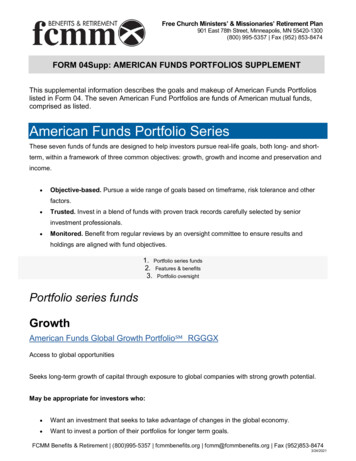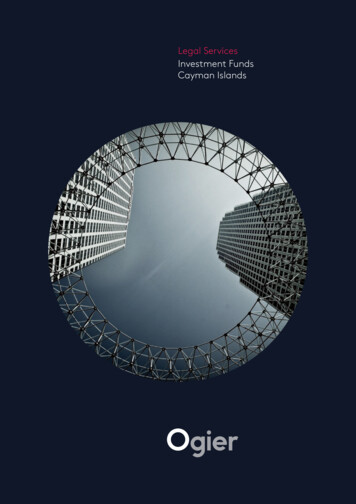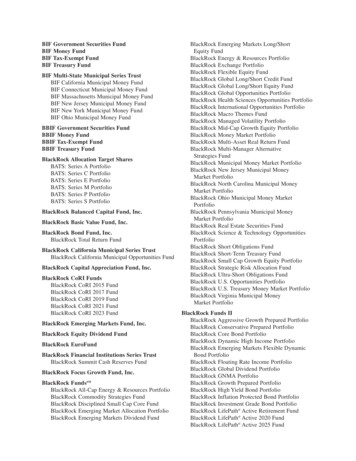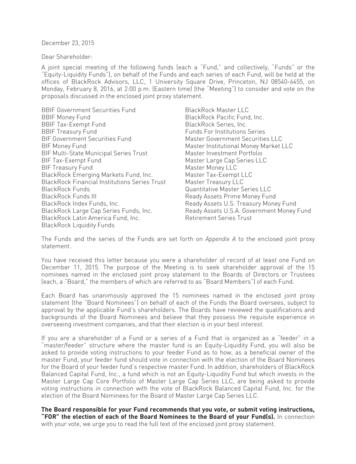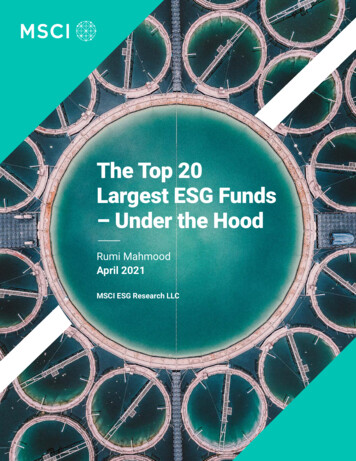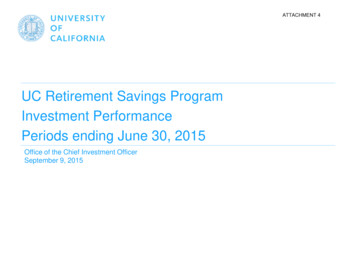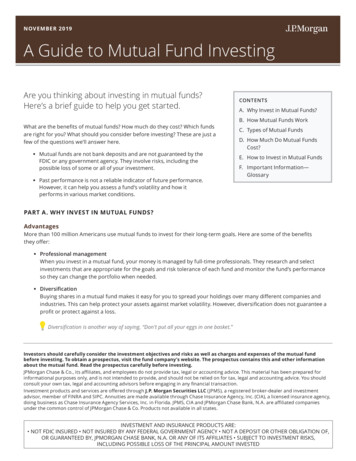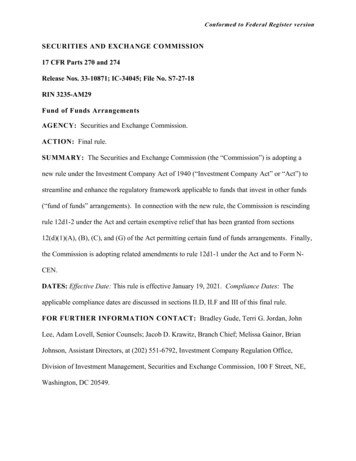
Transcription
Conformed to Federal Register versionSECURITIES AND EXCHANGE COMMISSION17 CFR Parts 270 and 274Release Nos. 33-10871; IC-34045; File No. S7-27-18RIN 3235-AM29Fund of Funds ArrangementsAGENCY: Securities and Exchange Commission.ACTION: Final rule.SUMMARY: The Securities and Exchange Commission (the “Commission”) is adopting anew rule under the Investment Company Act of 1940 (“Investment Company Act” or “Act”) tostreamline and enhance the regulatory framework applicable to funds that invest in other funds(“fund of funds” arrangements). In connection with the new rule, the Commission is rescindingrule 12d1-2 under the Act and certain exemptive relief that has been granted from sections12(d)(1)(A), (B), (C), and (G) of the Act permitting certain fund of funds arrangements. Finally,the Commission is adopting related amendments to rule 12d1-1 under the Act and to Form NCEN.DATES: Effective Date: This rule is effective January 19, 2021. Compliance Dates: Theapplicable compliance dates are discussed in sections II.D, II.F and III of this final rule.FOR FURTHER INFORMATION CONTACT: Bradley Gude, Terri G. Jordan, JohnLee, Adam Lovell, Senior Counsels; Jacob D. Krawitz, Branch Chief; Melissa Gainor, BrianJohnson, Assistant Directors, at (202) 551-6792, Investment Company Regulation Office,Division of Investment Management, Securities and Exchange Commission, 100 F Street, NE,Washington, DC 20549.
SUPPLEMENTARY INFORMATION: The Commission is adopting 17 CFR 270.12d1-4(new rule 12d1-4) under the Investment Company Act [15 U.S.C. 80a-1 et seq.]; 1 amendments to17 CFR 270.12d1-1 (rule 12d1-1) under the Investment Company Act; amendments toForm N-CEN [referenced in 17 CFR 274.101] under the Investment Company Act; andrescission of 17 CFR 270.12d1-2 (rule 12d1-2) under the Investment Company Act.Table of ContentsIntroduction . 3A. Regulatory Context . 6B. Rule 12d1-4 Overview . 10Discussion . 12A. Scope . 12B. Exemptions from the Act’s Prohibition on Certain Affiliated Transactions . 25C. Conditions . 33D. Rescission of Rule 12d1-2 and Amendment to Rule 12d1-1. 126E. Disclosures Relating to Fund of Funds Arrangements . 133F. Compliance Dates . 137Rescission of Exemptive Relief; Withdrawal of Staff Letters . 137Other Matters . 153Economic Analysis . 153A. Introduction . 153B. Economic Baseline. 154C. Benefits and Costs and Effects on Efficiency, Competition, and Capital Formation . 176D. Reasonable Alternatives. 226Paperwork Reduction Act . 239A. Introduction . 239B. Rule 12d1-4. 2401Unless otherwise noted, all references to statutory sections are to the Investment Company Act, and allreferences to rules under the Investment Company Act are to title 17, part 270 of the Code of FederalRegulations [17 CFR part 270].2
C. Rule 0-2. 251D. Form N-CEN. 252Final Regulatory Flexibility Analysis . 253A. Need for and Objectives of the Rule and Form Amendments . 253B. Significant Issues Raised by Public Comments . 254C. Small Entities Subject to the Rule . 256D. Projected Board Reporting, Recordkeeping, and Other Compliance Requirements . 257E. Agency Action to Minimize Effect on Small Entities . 260Statutory Authority . 262IntroductionWe are adopting new rule 12d1-4 under the Investment Company Act and several relatedamendments to streamline and enhance the regulatory framework applicable to fund of fundsarrangements. This framework reflects the Commission’s decades of experience with fund offunds arrangements and will create a consistent and efficient rules-based regime for theformation, operation, and oversight of fund of funds arrangements. 2 We believe that thisframework will provide investors with the benefits of fund of funds arrangements, and willprovide funds with investment flexibility to meet their investment objectives efficiently, in amanner consistent with the public interest and the protection of investors.Funds increasingly invest in other funds as a way to achieve asset allocation,diversification, or other investment objectives. According to staff estimates, approximately 40%of all registered funds hold an investment in at least one fund, 3 and total net assets in mutual2As discussed in more detail below, section 12(d)(1) of the Investment Company Act limits the ability of afund to invest substantially in securities issued by another fund. See 15 U.S.C. 80a-12(d)(1).3See infra Table 2. Of those funds investing in other funds, 48% invest at least 5% of their assets in otherfunds, and 26% hold more than 90% of their assets in other funds. See infra Table 4. For more data onfund of funds arrangements, see infra section VI.3
funds that invest primarily in other mutual funds have grown from 469 billion in 2008 to 2.54trillion in 2019. 4 Retail investors similarly use fund of funds arrangements as a convenient wayto allocate and diversify their investments through a single, professionally managed portfolio.For example, a fund of funds may provide an investor with the same benefits as separate directinvestments in several underlying funds, without the increased monitoring and recordkeepingthat could accompany investments in each underlying fund. 5In December 2018, we proposed rule 12d1-4, which would permit a fund to acquireshares of another fund in excess of the limits of section 12(d)(1) without obtaining an exemptiveorder from the Commission, subject to certain conditions. 6 Because the proposed rule wouldprovide a comprehensive exemption for funds of funds to operate, the Commission also proposedto rescind rule 12d1-2 under the Act and individual exemptive orders permitting certain fund offunds arrangements. In connection with the proposed rescission of rule 12d1-2, we proposedamendments to rule 12d1-1 under the Act to allow funds that rely on section 12(d)(1)(G) of the4During this period the number of mutual funds utilizing this arrangement grew from 838 to 1,469. SeeInvestment Company Institute, 2020 Fact Book: A Review of Trends and Activities in the InvestmentCompany Industry (“2020 ICI Fact Book”), at 244, available athttps://www.ici.org/pdf/2020 factbook.pdf.5Target-date funds are a common type of fund of funds arrangement and are designed to make it easier forinvestors to hold a diversified portfolio of assets that is rebalanced over time without the need for investorsto rebalance their own portfolio. See Investment Company Advertising: Target Date Retirement FundNames and Marketing, Investment Company Act Release No. 29301 (June 16, 2010) [75 FR 35920 (June23, 2010)] (proposing disclosure requirements for target date retirement funds’ marketing materials).6See Fund of Funds Arrangements, Investment Company Act Release No. 10590 (Dec. 19, 2018) [84 FR1286 (Feb 1, 2019)] (“2018 FOF Proposing Release”). For purposes of this release and rule 12d1-4, wegenerally use the term “funds” to refer to registered investment companies and business developmentcompanies (“BDCs”) unless the context otherwise requires. A BDC is a closed-end fund that: (i) isorganized under the laws of, and has its principal place of business in, any state or states; (ii) is operated forthe purpose of investing in securities described in section 55(a)(1)-(3) of the Act and makes available“significant managerial assistance” to the issuers of those securities, subject to certain conditions; and (iii)has elected under section 54(a) of the Act to be subject to the sections addressing activities of BDCs underthe Act. See 15 U.S.C. 80a-2(a)(48). Section 6(f) of the Act exempts BDCs that have made the electionunder section 54 of the Act from registration provisions of the Act.4
Act to invest in money market funds that are not part of the same group of investmentcompanies. Finally, the Commission proposed certain disclosure amendments to Form N-CENto provide the Commission additional census-type information regarding fund of fundsarrangements.We received more than 100 comment letters on the proposal. 7 Many commenterssupported the Commission’s goal of simplifying the regulatory framework for fund of fundsarrangements. 8 However, commenters recommended modifications to the proposed rule. 9 Forexample, several commenters suggested changing the scope of arrangements permitted by therule or expanding the scope of certain exemptions. 10 Many commenters also recommendedalternatives to the proposed rule’s conditions. For instance, commenters strongly opposed theproposed redemption limit and recommended instead codifying certain conditions in existingexemptive orders or applying the limitation only to unaffiliated fund of funds arrangements. 117The comment letters on the 2018 FOF Proposing Release (File No. S7-27-18) are available .8See, e.g., Comment Letter of Managed Funds Association (April 30, 2019) (“MFA Comment Letter”);Comment Letter of Investment Company Institute (April 30, 2019) (“ICI Comment Letter”); CommentLetter of Investment Adviser Association (May 2, 2019) (“IAA Comment Letter”); Comment Letter ofConsumer Federation of America (May 2, 2019) (“CFA Comment Letter”); Comment Letter of the AssetManagement Group of the Securities Industry and Financial Markets Association (May 2, 2019) (“SIFMAAMG Comment Letter”); Comment Letter of Federal Regulation of Securities Committee of the BusinessLaw Section of the American Bar Association (June 11, 2019) (“ABA Comment Letter”).9See, e.g., ICI Comment Letter; ABA Comment Letter; SIFMA AMG Comment Letter; Comment Letter ofthe Committee on Investment Management Regulation of the New York City Bar Association (May 2,2019) (“NYC Bar Comment Letter”); Comment Letter of Institute for Portfolio Alternatives (May 1, 2019)(“IPA Comment Letter”); Comment Letter of Fidelity Investments (May 2, 2019) (“Fidelity CommentLetter”).10See, e.g., MFA Comment Letter; NYC Bar Comment Letter; CFA Comment Letter; Comment Letter of T.Rowe Price (May 2, 2019) (“TRP Comment Letter”).11See, e.g., Comment Letter of Guggenheim Investments (May 2, 2019) (“Guggenheim Comment Letter”);Comment Letter of Dimensional Funds (May 2, 2019) (“Dimensional Comment Letter”); Comment Letterof Wells Fargo Funds Management, LLC (May 2, 2019) (“Wells Fargo Comment Letter”); CommentLetter of Federated Investors, Inc. (May 2, 2019) (“Federated Comment Letter”); SIFMA AMG CommentLetter; Fidelity Comment Letter; NYC Bar Comment Letter.5
Several commenters recommended modifications to the proposed rule’s control and votingprovisions, while some commenters proposed changes to the proposed rule’s disclosure andboard reporting requirements. 12 Some commenters expressed concern about the potential impactof the proposed rule’s conditions on existing fund of funds arrangements, particularly in light ofthe proposed rescission of rule 12d1-2 and existing exemptive orders. 13After consideration of the comments we received, we are adopting rule 12d1-4 withseveral modifications designed to increase the workability of the rule’s requirements, whileenhancing protections for investors in fund of funds arrangements. We are also rescinding rule12d1-2 and exemptive relief that permitted certain fund of funds arrangements, amending rule12d1-1 under the Act, and amending Form N-CEN.A.Regulatory ContextSection 12(d)(1) of the Act limits the ability of a fund to invest substantially in securitiesissued by another fund. Section 12(d)(1)(A) of the Act prohibits a registered fund (andcompanies, including funds, it controls) from: acquiring more than 3% of another fund’s outstanding voting securities; investing more than 5% of its total assets in any one fund; or investing more than 10% of its total assets in funds generally. 1412See, e.g., MFA Comment Letter; ICI Comment Letter; IPA Comment Letter; SIFMA AMG CommentLetter; Fidelity Comment Letter; Comment Letter of PGIM Investments LLC (May 2, 2019) (“PGIMComment Letter”); TRP Comment Letter.13See, e.g., Comment Letter of Pacific Investment Management Company LLC (May 1, 2019) (“PIMCOComment Letter”); Federated Comment Letter; SIFMA AMG Comment Letter; Fidelity Comment Letter;NYC Bar Comment Letter.14See 15 U.S.C. 80a-12(d)(1)(A). Both registered and unregistered investment companies are subject to theselimits with respect to their investments in a registered investment company. Registered investmentcompanies are also subject to these same limits with respect to their investment in an unregisteredinvestment company. Sections 3(c)(1) and 3(c)(7) subject private funds to the 3% limitation oninvestments in registered funds. 15 U.S.C. 80a-3(c)(1) and 3(c)(7)(D). A “private fund” is an issuer that6
Section 12(d)(1)(B) of the Act addresses the other side of the transaction by prohibiting aregistered open-end fund, 15 and any principal underwriter thereof or broker-dealer registeredunder the Securities Exchange Act of 1934 (the “Exchange Act”), from knowingly sellingsecurities to any other investment company if, after the sale, the acquiring fund would: together with companies it controls, own more than 3% of the acquired fund’soutstanding voting securities; or together with other funds (and companies they control), own more than 10% of theacquired fund’s outstanding voting securities. 16These restrictions are designed to prevent fund of funds arrangements that allow theacquiring fund to control the assets of the acquired fund and use those assets to enrich theacquiring fund at the expense of acquired fund shareholders. 17 Congress also was concernedabout the potential for duplicative and excessive fees when one fund invested in another and theformation of overly complex structures that could be confusing to investors. 18would be an investment company, as defined in section 3 of the Act, but for section 3(c)(1) or 3(c)(7) of theAct. 15 U.S.C. 80b-2(a)(29). In addition, section 60 of the Act makes section 12(d) applicable to a BDC tothe same extent as it if were a registered closed-end fund. 15 U.S.C. 80a-60.15A registered open-end fund is a management company that is offering for sale or has outstanding anyredeemable security of which it is the issuer. 15 U.S.C. 80a-5(a)(1) (defining “open-end company”). Aregistered closed-end fund is any management company other than an open-end fund. 15 U.S.C. 80a5(a)(2) (defining “closed-end company”). Section 12(d)(1)(C) of the Act also includes specific limitationson investments in registered closed-end funds. See 15 U.S.C. 80a-12(d)(1)(C).16See 15 U.S.C. 80a-12(d)(1)(B).17This practice is described as “pyramiding.” See 2018 FOF Proposing Release, supra footnote 6, at 1287.Control could be exercised either directly (such as through the voting power of a controlling interest) orindirectly (such as coercion through the threat of large-scale redemptions). See id.18Controlling persons profited when acquiring fund shareholders paid excessive fees due to duplicativecharges at both the acquiring and acquired fund levels. See Investment Trusts and Investment Companies,Report of the Securities and Exchange Commission, H.R. Doc. No. 136, 77th Cong., 1st Sess., at ch. 7,2725–39, 2760–75, 2778–93, (1941) (“Investment Trust Study”) and Exchange-Traded Funds, InvestmentCompany Act Release No. 28193 (Mar. 11, 2008) [73 FR 14618 (Mar. 18, 2008)] (“2008 ETF ProposingRelease”), at n. 195. See also 2018 FOF Proposing Release, supra footnote 6, at 9.7
As discussed in the 2018 FOF Proposing Release, our views and those of Congress haveevolved over the years as fund of funds structures developed that include investor protectionsand serve purposes that benefit investors. 19 As a result, Congress created three statutoryexceptions that permit different types of fund of funds arrangements subject to certainconditions. 20 Congress also gave the Commission authority in section 12(d)(1)(J) of the Act toexempt any person, security, or transaction, or any class or classes of transactions, from therestrictions of section 12(d)(1) if the exemption is consistent with the public interest and theprotection of investors. 21We previously exercised this exemptive authority to adopt three rules of generalapplicability that were based on relief we provided to specific market participants in exemptiveorders. 22 We also have used our authority under section 12(d)(1)(J) to issue exemptive orderspermitting fund of funds arrangements that the Act or our rules would otherwise prohibit whenwe found those arrangements to be consistent with the public interest and the protection of19See Fund of Funds Investments, Investment Company Act Release No. 27399 (June 20, 2006) [71 FR36640 (June 27, 2006)] (“2006 FOF Adopting Release”) at n.7 and accompanying text; 2008 ETFProposing Release, supra footnote 18. See also 2018 FOF Proposing Release, supra footnote 6, at 10-13.20See 15 U.S.C. 80a-12(d)(1)(E) (permitting master-feeder arrangements whereby an acquiring fund investsall of its assets in a single fund), 15 U.S.C. 80a-12(d)(1)(F) (permitting a fund to take small positions (up to3% of another fund’s securities) in an unlimited number of other funds), and 15 U.S.C. 80a-12(d)(1)(G)(permitting an open-end fund or unit investment trust (“UIT”) to invest in other open-end funds and UITsthat are in the “same group of investment companies”).21See National Securities Markets Improvement Act of 1996 (“NSMIA”), Pub. L. No. 104-290, 110 Stat.3416 (1996), at § 202(4) (codified at 15 U.S.C. 80a-12(d)(1)(J)); Comm. On Commerce, SecuritiesAmendments of 1996, H.R. Rep. No. 104-622 (1996), 104th Cong., 2nd Sess., at 43-44 (“H.R. Rep. No.622”). Congress added section 12(d)(1)(J) to resolve questions regarding the scope of the Commission’sauthority under section 6(c) of the Act.22See 2006 FOF Adopting Release, supra footnote 19. Rule 12d1-1 allows funds to invest in shares ofmoney market funds in excess of the limits of section 12(d)(1). Rule 12d1-2 provides funds relying onsection 12(d)(1)(G) with greater flexibility to invest in other types of securities. Rule 12d1-3 allowsacquiring funds relying on section 12(d)(1)(F) to charge sales loads greater than 1.5%.8
investors. 23 These exemptive orders permit fund investments in other funds, subject to specifiedconditions that are designed to prevent the abuses that led Congress to enact section 12(d)(1). 24Relief from sections 12(d)(1)(A) and (B) was included in exemptive orders permitting exchangetraded funds (“ETFs”) and exchange-traded managed funds (“ETMFs”) to operate. 25The combination of statutory exemptions, Commission rules, and exemptive orders hascreated a regulatory regime where substantially similar fund of funds arrangements are subject todifferent conditions. For example, an acquiring fund could rely on section 12(d)(1)(G) and rule12d1-2 when investing in an acquired fund within the same group of investment companies. 26Alternatively, the acquiring fund could rely on relief provided by an exemptive order, whichwould allow it to invest in substantially the same investments, but could require the fund tocomply with different conditions. Over time, industry participants have experimented with new23As the orders are subject to terms and conditions set forth in the applications requesting exemptive relief,references in this release to “exemptive relief” or “exemptive orders” include the terms and conditionsdescribed in the related applications. See, e.g., Schwab Capital Trust, et al., Investment Company ActRelease Nos. 24067 (Oct. 1, 1999) [64 FR 54939 (Oct. 8, 1999)] (notice) and 24113 (Oct. 27, 1999) (order)and related application (“Schwab”). In addition to our section 12(d)(1)(J) authority, we have issued theseorders pursuant to our exemptive authority under sections 17(a) and 6(c) of the Act.24The conditions include: (i) limits on the control and influence an acquiring fund can exert on the acquiredfund; (ii) limits on certain fees charged to the acquiring fund and its shareholders; and (iii) limits on theacquired fund’s ability to invest in other funds. See Schwab, supra footnote 23.25We recently adopted rule 6c-11, which permits certain ETFs to operate without obtaining an exemptiveorder. 17 CFR 270.6c-11. In adopting rule 6c-11, we did not rescind the portions of existing ETFexemptive orders that provided relief from sections 12(d)(1)(A) and (B) and stated that ETFs relying onrule 6c-11 that do not have exemptive relief from sections 12(d)(1)(A) and (B) may enter into fund of fundsarrangements as set forth in recent ETF exemptive orders, provided that such ETFs satisfy the terms andconditions for fund of funds relief in those orders. Exchange-Traded Funds, Investment Company ActRelease No. 33646 (Sep. 25, 2019) [84 FR 57162 (Oct. 24, 2019)] (“2019 ETF Adopting Release”), at57199.For purposes of this release, we generally use the term “ETFs” to refer to exchange-traded funds andexchange-traded managed funds unless the context otherwise requires.26Such a fund would rely on section 12(d)(1)(G) to invest in acquired funds within the same group ofinvestment companies, government securities, and short term paper. In addition, the fund could rely onrule 12d1-2 to invest in: (i) securities of funds that are not in the same group of investment companies up tothe limits in section 12(d)(1)(A) or (F); (ii) securities of money market funds in reliance on rule 12d1-1;and (iii) stocks, bonds, and other securities.9
fund of funds structures, relying on combinations of statutory exemptions and Commissionexemptive orders, and considering staff no-action letters, to create novel fund of fundsarrangements. For example, some commenters described funds that have combined variousforms of section 12(d)(1) relief to create fund structures that include three or more layers offunds. 27B.Rule 12d1-4 OverviewIn order to create a more consistent and efficient regulatory framework for fund of fundsarrangements, rule 12d1-4 will permit a registered investment company or business developmentcompany (“BDC”) (collectively, “acquiring funds”) to acquire the securities of any otherregistered investment company or BDC (collectively, “acquired funds”) in excess of the limits insection 12(d)(1), subject to the following conditions: Control. Rule 12d1-4 will prohibit an acquiring fund and its “advisory group”from controlling an acquired fund, except in certain limited circumstances. Voting. Rule 12d1-4 will require an acquiring fund and its advisory group to usemirror voting if it holds more than 25% of an acquired open-end fund or UIT dueto a decrease in the outstanding securities of the acquired fund and if it holdsmore than 10% of a closed-end fund, with the ability to use pass-through votingwhen acquiring funds are the only shareholders of an acquired fund. 28 Required Findings. Rule 12d1-4 will require investment advisers to acquiring andacquired funds that are management companies to make certain findingsregarding the fund of funds arrangement, after considering specific factors. The27See, e.g., Fidelity Comment Letter; Federated Comment Letter; Comment Letter of Federated Investors,Inc. (June 7, 2019) (“Federated 2 Comment Letter”).28See infra section II.C.1.b.ii.10
final rule also will require certain findings with respect to UITs and separateaccounts funding variable insurance contracts, taking into account the uniquestructural characteristics of such entities. Fund of Funds Investment Agreement. Rule 12d1-4 will require funds that do nothave the same investment adviser to enter into an agreement prior to the purchaseof acquired fund shares in excess of section 12(d)(1)’s limits (a “fund of fundsinvestment agreement”). Complex Structures. Rule 12d1-4 will impose a general three-tier prohibitionwith certain enumerated exceptions. However, in addition to these exceptions, therule will allow an acquired fund to invest up to 10% of its total assets in otherfunds (including private funds), without regard to the purpose of the investment ortypes of underlying funds.As proposed, we are rescinding rule 12d1-2 under the Act, and amending rule 12d1-1 toallow funds that rely on section 12(d)(1)(G) to invest in money market funds that are not part ofthe same group of investment companies in reliance on that rule. 29 In addition, certain staff noaction letters relating to section 12(d)(1) will be withdrawn. 30 The resulting regulatoryframework will reduce confusion and subject similar fund of funds arrangements to tailoredconditions that will enhance investor protection, while continuing to provide funds withinvestment flexibility to meet their investment objectives. In addition, the rule will allow the29With the rescission of rule 12d1-2, a fund relying on section 12(d)(1)(G) will no longer have flexibility to:(i) acquire the securities of other funds that are not part of the same group of investment companies; or (ii)invest directly in stocks, bonds, and other securities, except in compliance with rule 12d1-4.30The list of no-action letters to be withdrawn will be available on the Commission’s website.11
Commission, as well as funds and advisers seeking exemptions, to focus exemptive order reviewresources on novel products or arrangements.DiscussionA.Scope1.Registered Funds and BDCsAs proposed, rule 12d1-4 will permit registered investment companies and BDCs toacquire the securities of other registered investment companies or BDCs in excess of the limits insection 12(d)(1). As a result, open-end funds (including ETFs), UITs (including ETFs organizedas UITs), and closed-end funds (including BDCs), can operate in accordance with rule 12d1-4, asboth acquiring and acquired funds. 31 The scope of permissible acquiring and acquired fundsunder rule 12d1-4 is greater than the scope of funds that was permitted by the Commission’sexemptive orders. For example, the rule will allow open-end funds, UITs, and ETFs to invest inunlisted closed-end funds and unlisted BDCs beyond the limits in section 12(d)(1). 32 The rulesimilarly will increase permissible investments for closed-end funds beyond ETFs to allow themto invest in open-end funds, UITs, other closed-end funds, and BDCs, in excess of the section31As proposed, the final rule will not be available to face-amount certificate companies. Face-amountcertificate companies are registered investment companies that are engaged or propose to engage in thebusiness of issuing face-amount certificates of the installment type, or which have been engaged in suchbusinesses and have any such certificates outstanding. See section 4(1) of the Investment Company Act.There is only one face-amount certificate company currently operating as an investment company andmaking current filings pursuant to section 13 [15 U.S.C. 80a-13] or section 15(d) of the Exchange Act [15U.S.C. 80a-15]. Given the very limited universe of face-amount certificate companies and the nature oftheir investments, face-amount certificate companies are not within the scope of final rule 12d1-4 as eitheracquiring funds or acquired funds. No commenters addressed this aspect of the proposal.32We use the terms “listed closed-end funds” and “listed BDCs” to refer to closed-end funds and BDCs thatare listed and traded on national securities exchanges. Our exemptive orders have included a representationthat acquiring funds will not invest in reliance on the order in closed-end funds or BDCs that are not listedand traded on a national securities exchange. See, e.g., Innovator ETFs Trust, et al., Investment CompanyAct Release Nos. 33214 (Aug. 24, 2018) [83 FR 44374 (Aug. 30, 2018)] (notice) and 33238 (Sept. 19,2018) (
Fund of Funds Arrangements, Investment Company Act Release No. 10590 (Dec. 19, 2018) [84


